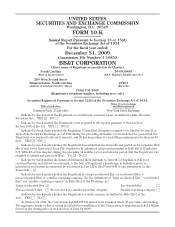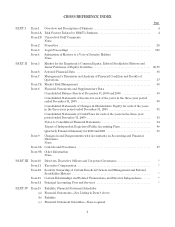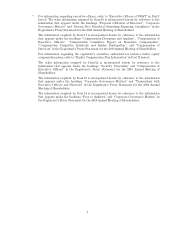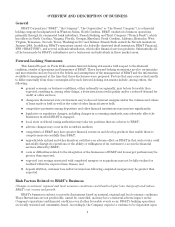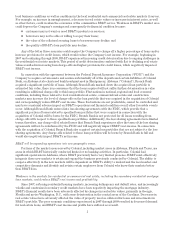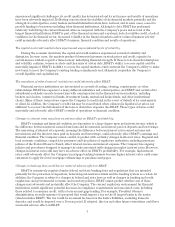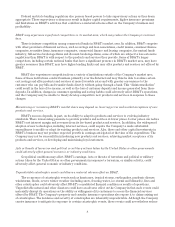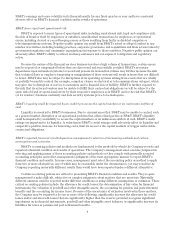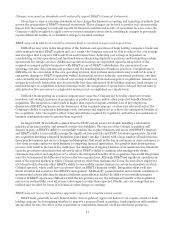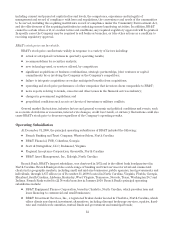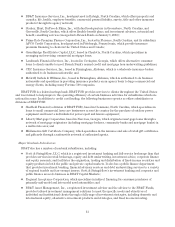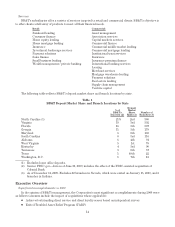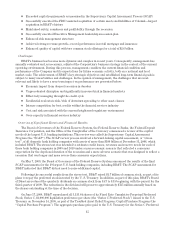BB&T 2009 Annual Report Download - page 6
Download and view the complete annual report
Please find page 6 of the 2009 BB&T annual report below. You can navigate through the pages in the report by either clicking on the pages listed below, or by using the keyword search tool below to find specific information within the annual report.The declines in home prices in many markets across the U.S., including a number of markets in BB&T’s
banking footprint (primarily in Georgia, Florida, and metro Washington, D.C., with some deterioration in the
coastal areas of the Carolinas), along with the reduced availability of mortgage credit, also has resulted in
increases in delinquencies and losses in BB&T’s portfolio of loans related to residential real estate, including its
acquisition, development and construction loan portfolio. Further declines in home prices within BB&T’s banking
footprint (including markets that to date have not experienced significant declines) coupled with the continued
impact of the economic recession and high unemployment levels could drive losses beyond the levels provided for
in BB&T’s allowance for loan losses. In that event, BB&T’s future earnings would be adversely affected.
Significant ongoing disruption in the secondary market for residential mortgage loans has limited the market
for and liquidity of most mortgage loans other than conforming Fannie Mae, Freddie Mac and Ginnie Mae loans.
The effects of ongoing mortgage market challenges, combined with the ongoing correction in residential real
estate market prices and reduced levels of home sales has resulted in price reductions in single family home
values, adversely affecting the value of collateral securing mortgage loans held and mortgage loan originations.
Continued declines in real estate values and home sales volumes within BB&T’s banking footprint, and financial
stress on borrowers as a result of job losses, or other factors, could have further adverse effects on borrowers
that result in higher delinquencies and greater charge-offs in future periods, which would adversely affect
BB&T’s financial condition and results of operations.
The Colonial acquisition has increased Branch Bank’s commercial real estate and construction loan portfolio,
which have a greater credit risk than residential mortgage loans.
With the acquisition of the Colonial loan portfolio, the commercial real estate loan and construction loan
portfolios have become a larger portion of Branch Bank’s total loan portfolio than it was prior to the Colonial
acquisition. This type of lending is generally considered to have more complex credit risks than traditional single-
family residential lending, because the principal is concentrated in a limited number of loans with repayment
dependent on the successful operation of the related real estate or construction project. Consequently, these loans
are more sensitive to the current adverse conditions in the real estate market and the general economy. These
loans are generally less predictable, more difficult to evaluate and monitor, and collateral may be more difficult to
dispose of in a market decline. However, the negative economic aspects of these risks are substantially reduced as
a result of the FDIC loss sharing agreements.
Increases in FDIC insurance premiums may adversely affect BB&T’s net income and profitability.
During 2008 and continuing in 2009, higher levels of bank failures have dramatically increased resolution
costs of the FDIC and depleted the deposit insurance fund. In addition, the FDIC instituted two temporary
programs to further insure customer deposits at FDIC insured banks: deposit accounts are now insured up to
$250,000 per customer (up from $100,000) and noninterest-bearing transactional accounts are currently fully
insured (unlimited coverage). These programs have placed additional stress on the deposit insurance fund. In
order to maintain a strong funding position and restore reserve ratios of the deposit insurance fund, the FDIC
has increased assessment rates of insured institutions. In addition, on November 12, 2009, the FDIC adopted a
rule requiring banks to prepay three years’ worth of estimated deposit insurance premiums by December 31,
2009. BB&T is generally unable to control the amount of premiums that the Company is required to pay for FDIC
insurance. If there are additional bank or financial institution failures, or the cost of resolving prior failures
exceeds expectations, the Company may be required to pay even higher FDIC premiums than the recently
increased levels. These announced increases and any future increases or required prepayments of FDIC
insurance premiums may adversely impact BB&T’s earnings and financial condition.
Market developments may adversely affect BB&T’s industry, business and results of operations.
Significant declines in the housing market, with falling home prices and increasing foreclosures and
unemployment, have resulted in significant write-downs of asset values by many financial institutions, including
government-sponsored entities and major commercial and investment banks. These write-downs, initially of
mortgage-backed securities but spreading to credit default swaps and other derivative securities, caused many
financial institutions to seek additional capital, to merge with larger and stronger institutions and, in some cases,
to fail. BB&T has produced quarterly earnings during 2008 and 2009; however, during this time BB&T has
6

